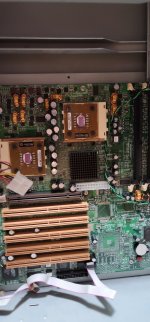hunterjwizzard
Veteran Member
- Joined
- Mar 20, 2020
- Messages
- 2,302
At VCFSoCal I found a gorgeous dual opteron motherboard with 32GB of RAM on the free table. Lover that I am of all thinks SMP, I had to have it.
I am finally now making some progress on using it for something, and creating this thread to document my experiments and tests.
First thing, I had to find heat sinks for it, which proved VERY challenging. Most because I am a cheap SOB and did not want to spend $60 each.
Once I had some HSFs($36 for a pair of coolermasters) I finally got the machine to POST. Turns out this is the mainboard out of an HP xw9400 workstation. Quite an interesting device.
So far getting it to boot consistently is proving to be something of a challenge. As was getting it to take an operating system. At this point I can't say for sure if the machine will ever be reliable enough for what I want to do with it. But at the end of the day I'm just happy to be using such a supremely monsterious board.
Future goals for the project: I have GOT to find a better case for it. At present I've fit it juuuuust barely in an old Chieftec Dragon, and I have not got a better case for what I want to do anywhere in my collection. Finding EATX cases is proving a challenge.
Up next: my furtive searches indicate this board might actually do SLI. Having a dual socket SLI system is very high on my wishlists, so this excites me. However I want space for peripheral cards, so most probably I will be finding some single slot quadro cards for SLI. I'm very excited about this not quite retro machine.
I am finally now making some progress on using it for something, and creating this thread to document my experiments and tests.
First thing, I had to find heat sinks for it, which proved VERY challenging. Most because I am a cheap SOB and did not want to spend $60 each.
Once I had some HSFs($36 for a pair of coolermasters) I finally got the machine to POST. Turns out this is the mainboard out of an HP xw9400 workstation. Quite an interesting device.
So far getting it to boot consistently is proving to be something of a challenge. As was getting it to take an operating system. At this point I can't say for sure if the machine will ever be reliable enough for what I want to do with it. But at the end of the day I'm just happy to be using such a supremely monsterious board.
Future goals for the project: I have GOT to find a better case for it. At present I've fit it juuuuust barely in an old Chieftec Dragon, and I have not got a better case for what I want to do anywhere in my collection. Finding EATX cases is proving a challenge.
Up next: my furtive searches indicate this board might actually do SLI. Having a dual socket SLI system is very high on my wishlists, so this excites me. However I want space for peripheral cards, so most probably I will be finding some single slot quadro cards for SLI. I'm very excited about this not quite retro machine.





